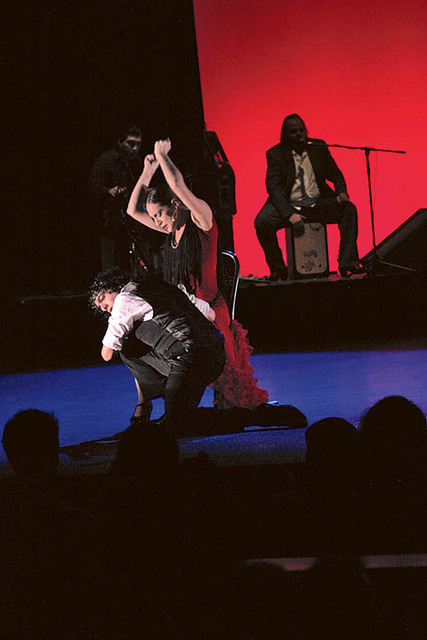The centuries-old flamenco tradition hits another milestone in Albuquerque. Yjastros: The American Flamenco Repertory Company celebrates its 20 th anniversary with an endurance test of sorts. The company will perform its entire repertory in a single weekend in three shows collectively called Blanco, Rojo y Negro ."For any repertory dance company—for New York City Ballet, for American Ballet Theatre—it’s rare that you’d be able to see their entire repertory at one time," says Eva Encinias-Sandoval, the company’s executive director. "The concept of a repertory company in the world of flamenco dance is pretty unique. There aren’t many outside of the state. Even in Spain, this is a unique resource." Decades before Yjastros was established, Encinias-Sandoval trained in flamenco at her mother’s Albuquerque studio from age 5. She joined the UNM faculty in 1976, where she pushed to get flamenco as a degree track in the dance department. "An interesting correlation with the company is that there’s a lot of cooperation and collaboration between the university flamenco dancers and projects of the National Institute of Flamenco (NIF), Yjastros being one of them," the executive director explains. "Many Yjastros company members are flamenco students at UNM."Yjastros artistic director Joaquin Encinias—also Encinias-Sandoval’s son—initiated the plan for a stateside flamenco repertory company. Encinias-Sandoval had already founded the NIF in 1992. Her son wanted to start a repertory flamenco company but recognized the need to first establish a school that could train dancers locally, fueling the company’s talent pool with lifelong flamenco artists. He, along with dancer Omayra Amaya, Encinias-Sandoval and her daughter Marisol Encinias, founded the Conservatory of Flamenco Arts. The conservatory now operates as the educating branch of the NIF.Today, children as young as 5 years old train with the conservatory’s Niños Flamencos performance group. "In the best of all worlds, you need to develop the musicality and cultural appreciation from very young," Encinias-Sandoval says. The conservatory also offers adult classes. Students 15 years old and up typically enroll in the Alma Flamenca performance group before moving into Yjastros company apprenticeships. Dancer development is a piece of Blanco, Rojo y Negro that the executive director says she finds rewarding. “The wonderful thing about this is you can’t help but reminisce about the dancers from where they started and to where they are today.”Yjastros never puts away choreography for more than a single season. The company’s hierarchy—dancers move from apprenticeships to soloist positions before becoming principle dancers—is an operating procedure Encinias-Sandoval says helped the company prepare 17 pieces to perform over three nights. Dancers are able to learn dances in rounds as they move through the company ranks, making it easier to prepare the whole repertory for performance.The technical aspect of preparing an entire company repertory still presents challenges. "The National Hispanic Cultural Center is working very hard to make this work for us," Encinias-Sandoval says. "Because of the color palette we’re working with, we not only have to change lighting plots, we have to change everything—floor color, legs of theater; everything has to change from one concert to another."The color palette is crucial; each show’s theme has been constructed around a color for Blanco, Rojo y Negro . “Between the three nights, there are very distinct flavors of flamenco," says Encinias-Sandoval. "For Blanco , the entire theater, even the stage, will be white. Same thing for red and black; each evening will be visually very dynamic." She likens the white stage to a canvas onto which the Blanco pieces, all choreographed by the company’s artistic director, will be painted.Encinias-Sandoval characterizes Rojo as fiery and filled with dance and dress that are iconically flamenco. “ Rojo is much more traditional in feel,” she says. “I don’t want to say standard, because that’s not a good word to use to describe anything in flamenco. But in a staging way, it’s simple and dynamic.” Yjastros’ final performance is a collection of the company’s less traditional pieces. “ Negro is more contemporary. I like to use the word ‘urban,’ ” says Encinias-Sandoval. "In their feel they have a slick, edgy look to them.”After its anniversary weekend, Yjastros scales down the size and amps up the intimacy. In July, the company begins a five-week run of cabaret-style patio shows in Santa Fe and Albuquerque."I come from a pretty biased point of view, but I believe every time you see flamenco, you see it on many levels,” says Encinias-Sandoval. “But flamenco is very versatile in that way and each of those various settings—the NHCC stage, a restaurant patio—is powerful and magical.”Encinias-Sandoval says she recognizes that, as a flamenco repertory, Yjastros holds a special role. After 20 years, she says the next step is obvious. “Someday, this company needs to dance in Spain. The particular quality and character of this company is unique to the flamenco world; and our own American flamenco company, Yjastros, can perform in Spain.”
Blanco, Rojo y Negro opens at the National Hispanic Cultural Center on Thursday, June 11, at 7 p.m. and continues June 12 and 13 with shows at 8 p.m. Tickets are $20 to $30. There’s a $5 senior, student and NHCC member discount and buying two shows gets you a ticket to the third for free. Tickets are available at the NHCC box office and ticketmaster.com, or call 724-4771. For a list of venues in the Yjastros patio series, which starts in July, visit yjastros.nationalinstituteofflamenco.org.










